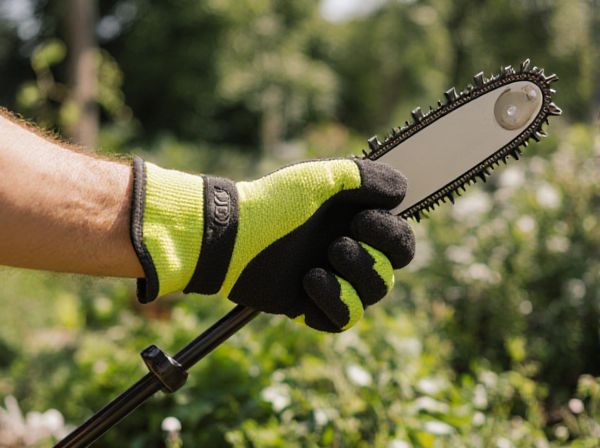
Pole saw vs Bow saw Illustration
A pole saw extends your reach for trimming high branches without the need for a ladder, making it ideal for maintaining tall trees efficiently. In contrast, a bow saw features a curved blade designed for cutting thicker branches and logs at ground level, offering greater control and power for heavy-duty tasks. Choosing between a pole saw and a bow saw depends on the height and thickness of the branches being trimmed, as well as the user's accessibility needs.
Table of Comparison
| Feature | Pole Saw | Bow Saw |
|---|---|---|
| Primary Use | Pruning high branches | Cutting small to medium logs |
| Design | Long extendable pole with saw blade | Curved metal frame with a straight blade |
| Cutting Capacity | Up to 15-20 feet high | Log diameter up to 6-12 inches |
| Portability | Bulky, less portable | Lightweight, easy to carry |
| Power Source | Manual, battery, or gas-powered | Manual only |
| Best For | Tree trimming, branch pruning | Firewood cutting, camping, woodworking |
| Maintenance | Blade sharpening and pole inspection | Blade sharpening and tension adjustment |
Introduction to Pole Saws and Bow Saws
Pole saws feature an extended handle with a small saw or chainsaw blade at the end, designed primarily for pruning high tree branches without the need for ladders. Bow saws are handheld cutting tools with a rigid, rectangular frame and a coarse-toothed blade ideal for cutting through logs and thick branches at ground level. Understanding the distinct design and use cases of pole saws and bow saws helps homeowners and landscapers select the appropriate tool for efficient tree trimming and wood cutting tasks.
Key Differences Between Pole Saws and Bow Saws
Pole saws feature an extendable handle designed for pruning high branches, offering reach and safety without requiring a ladder. Bow saws are manual folding saws with a bow-shaped frame, primarily used for cutting small to medium-sized branches close to the ground. Key differences include pole saws' long reach and motorized or manual operation versus bow saws' compact design and reliance on user strength for cutting.
Advantages of Using a Pole Saw for Gardening
A pole saw offers significant advantages for gardening by providing extended reach to trim high branches safely without the need for ladders, reducing the risk of falls. Its lightweight design and ergonomic handle increase maneuverability and reduce user fatigue during prolonged use. Compared to a bow saw, the pole saw's telescoping feature allows precise pruning in hard-to-reach areas, improving efficiency and maintaining plant health.
Benefits of Choosing a Bow Saw
Choosing a bow saw offers superior control and precision for cutting branches and logs with its narrow, tensioned blade designed for curved or detailed cuts. The lightweight frame and ergonomic handle reduce user fatigue during prolonged use, making it ideal for pruning and harvesting tasks. Compared to a pole saw, a bow saw provides greater versatility in maneuvering tight spaces and ensures cleaner, smoother cuts on wood.
Ideal Use Cases for Pole Saws
Pole saws are ideal for trimming and pruning high branches without the need for ladders, making them perfect for maintaining tall trees and hard-to-reach limbs. Their extended reach allows users to efficiently manage overhead growth in orchards, gardens, and landscapes. Unlike bow saws, which excel in cutting thicker, fallen wood at ground level, pole saws prioritize safety and convenience for elevated pruning tasks.
Best Applications for Bow Saws in the Garden
Bow saws excel in pruning thick branches and cutting firewood due to their sharp, coarse blades and robust frame, making them ideal for heavy-duty garden tasks. Their lightweight design and curved blade provide efficient control and clean cuts on green wood, perfect for shaping shrubs and clearing fallen branches. Unlike pole saws, bow saws require close proximity but offer greater precision and ease when working on mid-level garden maintenance.
Safety Considerations for Pole Saws vs Bow Saws
Pole saws require heightened safety precautions due to their extended reach and motorized chains, increasing risks of accidental contact and kickback, necessitating protective gear and stable footing. Bow saws, being manual and closer to the user, offer more control but still demand careful handling to avoid blade slippage or injury, especially when cutting dense wood. Understanding these safety differences is crucial for selecting the appropriate tool to minimize hazards during pruning or cutting tasks.
Maintenance Tips for Pole Saws and Bow Saws
Proper maintenance for pole saws involves regularly sharpening the chain, lubricating the bar, and inspecting tension to ensure efficient cutting and extend tool lifespan. Bow saws require consistent blade sharpening, cleaning after use to prevent rust, and tightening of the blade to maintain optimal cutting performance. Storing both pole saws and bow saws in dry, secure places prevents damage and prolongs their durability.
Cost Comparison: Pole Saw vs Bow Saw
Pole saws typically cost between $50 and $200, depending on the power source and cutting capacity, making them a higher upfront investment compared to bow saws, which usually range from $15 to $40. The maintenance expenses for pole saws can also be higher due to parts like chains, motors, and gas or batteries, while bow saws require minimal maintenance and have nearly negligible ongoing costs. For users prioritizing budget, bow saws offer a more affordable and low-maintenance solution, whereas pole saws provide greater efficiency and reach at a higher price point.
How to Choose the Right Saw for Your Gardening Needs
Choosing the right saw for gardening depends on your specific tasks: pole saws excel at pruning high branches and hard-to-reach areas due to their extended reach, while bow saws are ideal for cutting smaller branches and firewood with precision and ease. Consider factors such as the height of your trees, the thickness of branches, and the physical effort required, as pole saws often require less strain for elevated cuts. For versatility and portability, a bow saw is preferable, but for safety and efficiency when working overhead, a pole saw is the superior choice.
Pole saw vs Bow saw Infographic

 gardendif.com
gardendif.com